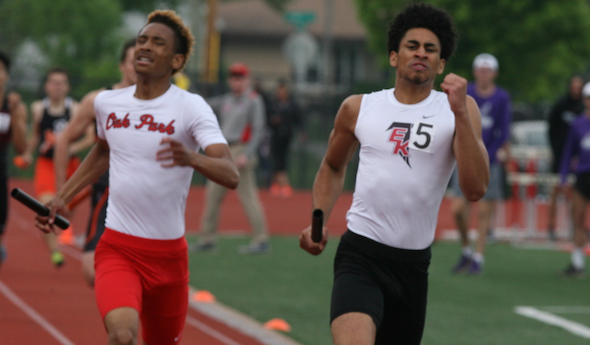
East Kentwood Adds Perfection to Streak
June 1, 2019
By Dean Holzwarth
Special for Second Half
KENTWOOD – A hard pounding rain began to fall shortly after the East Kentwood boys track & field team reached the podium.
It was only fitting, as the Falcons reigned once again.
East Kentwood completed a three-peat Saturday at home in the MHSAA Lower Peninsula Division 1 Finals.
The Falcons scored 63.5 points in winning the Finals for the eighth time in the last 11 years. They also won three consecutive championships from 2009-11.
Ann Arbor Pioneer placed runner-up with 43 points.
“An amazing group of kids that just fought and fought and fought all day,” East Kentwood coach Dave Emeott said.
The Falcons did so despite winning only three events. East Kentwood claimed top honors in the 800 and 1,600 relays, while Stephan Bracey won the long jump (24-1.25).
“We only had three firsts today, and everything else was a battle and they did it,” Emeott said. “They stepped up in every opportunity they had, and they hung together. They trusted each other as teammates and came out on top at the end of the day. I’m just so proud of this team.”
Junior Michael Osteno helped the winning 1,600 relay team as he joined Elijah Ealy, Junior Hie and Jeremiah Applewhite to clock a 3:18.54.
“It’s something you dream about, running on this track and winning another state championship,” Osteno said. “Going back-to-back-to-back was the goal today and we wanted to finish, execute and give an elite mindset to get that third one.
“We came out and did what we’ve been doing all season, and when it came time to step up like we knew other teams were going to do, that’s what we did.”
The victory also culminated a perfect season. The Falcons went undefeated in duals, in the conference championship and also won their Regional.
“At the beginning of the season the seniors talked about what we wanted to accomplish, and they talked about a perfect season,” Emeott said. “That hadn’t happened in the last couple years. They wanted to be perfect, and that’s hard to do, especially in the O-K Red, but they stepped up and did it.
“We have a lot of young athletes, and some of them sacrificed for the team. They did four or three events. The other day I said that I didn’t know why I was so stressed because I have nothing to be stressed about, because they are so nice and so great.”
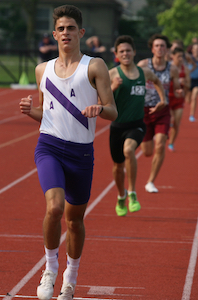 Ann Arbor Pioneer finished second for the second straight year and was led by senior standout Nick Foster, who capped an illustrious prep career with wins in the 1,600 (4:12.32) and 3,200 (9:08.55).
Ann Arbor Pioneer finished second for the second straight year and was led by senior standout Nick Foster, who capped an illustrious prep career with wins in the 1,600 (4:12.32) and 3,200 (9:08.55).
“This is the last time wearing a Pioneer uniform, and it’s been a crazy last four years,” Foster said. “I just wanted to go out with a bang, and our team got second. I’m going to miss all these guys, and it’s pretty awesome to go out like this.”
Foster competed in four events, and actually got a little rest because of delays due to inclement weather.
“I knew it was going to be a similar challenge, and I knew I was stronger coming in,” Foster said. “This year there was more of a goal of winning all the events and trying to place in the 1,600 relay.
“There was a lot of pressure coming back, but I knew I was strong enough to do all these events and I tried to take one race at a time. Mother Nature helped with the delays.”
Foster’s final race was the 3,200, which he won by a little more than two seconds ahead of Alpena’s Aden Smith.
“My third one, that was the toughest,” Foster said. “I knew I had to stay close, and I had confidence in my finish.”
Lansing Waverly’s Keshaun Harris repeated in the 300 hurdles (37.75) and also won the 110 hurdles (13.98) after placing runner-up last season.
Rockford’s Noah Stallworth also took home a pair of titles in the 100 (10.76) and 200 (21.64).
The following also collected individual championships: Grand Blanc’s Ethan Vargo (high jump), Brownstown Woodhaven’s Clarence Corbett (shot put), Alpena’s Gabe Bullis (pole vault), Alpena’s Eli Winter (discus), Novi’s Miles Brown (800) and Westland John Glenn’s James Flournoy (400).
PHOTOS: (Top) East Kentwood stays just ahead of Oak Park to claim a relay championship Saturday in LP Division 1. (Middle) Ann Arbor Pioneer's Nick Foster leads the way. (Photos by Carter Sherline. Click to see more from RunMichigan.com.)
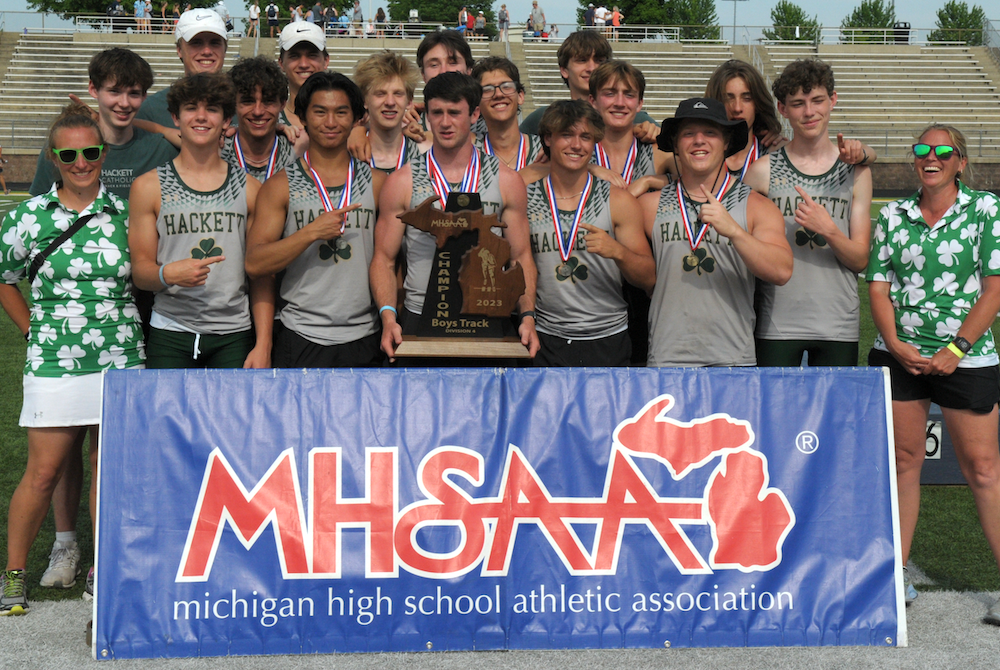
Thrower Claims Lone Individual Title to Lead Hackett to Team 3-Peat
By
Tom Lang
Special for MHSAA.com
June 3, 2023
Kalamazoo Hackett Catholic Prep just keeps winning and winning.
This time the Irish took home their fourth title in the last five Lower Peninsula Division 4 Track & Field Finals, on Saturday at Hudsonville.
Hackett’s only individual title was taken by discus winner Nathan Buchmann, a senior, who was fine knowing he was the shortest in stature among all the sizable competitors.
“In the offseason after football I worked out every day, working towards this goal,” he said after getting his medal. “I would say this takes 80 percent technique and 20 percent strength to throw the discus. So, length can help but if you have good technique and are really strong, that will play into it.
“I think we are very balanced throughout the meet today,” he said about teammates that scored points in finishes other than first place. “We have 13 guys here today, and we have people in a lot of the races. But I do not run; I have too short of legs to be a fast runner,” he said with a chuckle.
Buchmann had to work through a hip injury to compete this spring.
“I think the setbacks are what make you strong,” he said. “You can either give up through the setbacks or push forward and become better.”
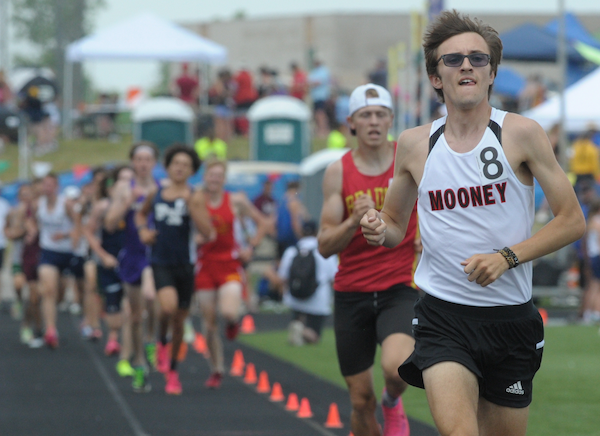 Coach Charissa Dean agreed.
Coach Charissa Dean agreed.
“The kids have big hearts,” she said after all the points were totaled and the Irish were on top once again, with 53. “They worked hard. They had a lot of potential when we started the season. And we had a lot of drive to put in the work, and we are happy the results came out the way they did.”
Reading was runner-up at 47 points, followed by Wyoming Potter’s House Christian with 42, then Fowler and Flint Beecher each with 37 points.
Senior Lezawe “Moses” Osterink, of Potter’s House Christian, placed second in 1,600 but took the 3,200 title as defending champ of both. He dominated the latter by lapping the field with a final lap kick that resembled more of a superhero speedster.
“Nobody really took it out that hard at the start,” he said. “There was a freshman (Marek Butkiewicz of Hackett) that tried to get the pace going quick, but me and Dakota (Dykhuis of Montabella) just kind of sat back and gradually pulled him through.
“We took it gradually, and I was just relying that I could kick.”
Kick did he ever. The trio were neck and neck the majority of the race in a grouping ahead of the pack.
“With 400 to go I just tried to go all out,” Osterink said. “I had a lot more left than I thought and I was pleased with the win. Not really the time, but that doesn’t matter, especially this hot out.”
The overall meet was in the low 90s/high 80s heat and searing sun all day. So, race officials allowed the unique opportunity for coaches to spray the runners with water and give them water bottles.
“It was very weird because I’ve never taken water to drink while I’m running, so I didn’t know how that would feel,” Osterink said. “And they were spraying us and hitting us in the face. It was kind of fun.”
Junior Tyler Lenn of Marine City Cardinal Mooney defeated Osterink at his own game in the 1,600.
“I’m feeling great,” Lenn said after grabbing the medal. “I said to a newspaper after one of my races (during the season) I was right where I wanted to be. This has been a long rebuilding process for me since an injury back in the fall, and I set a pretty high goal the day the injury happened. I was telling myself I needed to fulfill what I said I would do at the beginning of last cross country season. And that is what I did today.”
Lenn suffered an ankle sprain from a misstep that turned worse because he kept running through the season on it.
“Coming back from that was pretty tough, but I wouldn’t have it any other way,” he said. 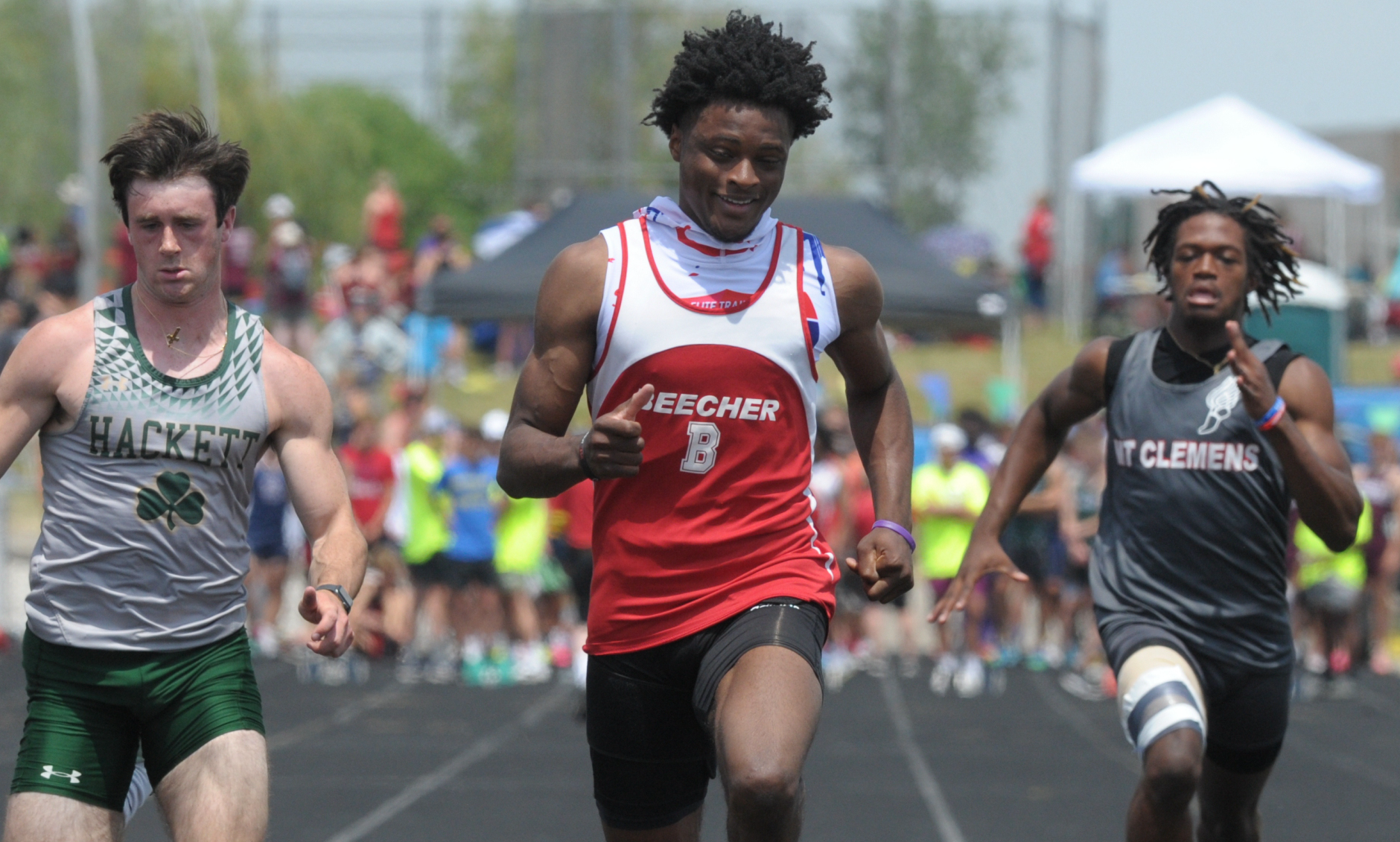 “Perseverance; I said from the beginning what I was going to do. I kept my eye on that target, and no matter the circumstances life threw at me, that I was going to make it happen and I am a man of my word.”
“Perseverance; I said from the beginning what I was going to do. I kept my eye on that target, and no matter the circumstances life threw at me, that I was going to make it happen and I am a man of my word.”
Jaylin Townsend, a senior from Flint Beecher, dominated the short races. He won the 100 dash (10.67) and 200 dash at 22 seconds flat. It was his third 100 win at a Finals.
“I put in a lot of work; I had to three-peat,” he said after the 100. “There’s a lot of great competition here, so I knew I had to come out and run my best.”
Concord in the 400 (43.72), Buckley in the 800 (1:30.76) and 1,600 (3:29.13) and Potter’s House in the 3,200 (8:14.18) were relay champs Saturday. Reading’s Tayshawn Bester won the 110 hurdles (15.13), and Athens’ Landen Bennett won the 300 (39.85). Caseville’s Nathan Feltner won the 400 (50.76), and Vestaburg’s Owen Patton claimed the 800 (1:55.11).
Fruitport Calvary Christian’s Bradley Richards won the high jump (6-10), and Peck’s Alex Affer won the long jump (23-4). McBain Northern Michigan Christian’s Isaac Bowden was first in pole vault (13-0), and Brown City’s Kyle Affer won shot put (49-2).
PHOTOS (Top) Kalamazoo Hackett Catholic Prep celebrates its third-straight LPD4 title Saturday. (Middle) Cardinal Mooney's Tyler Lenn, far right, sets the pace in the 1,600. (Below) Flint Beecher's Jaylin Townsend, middle, crosses the finish first for one of his two sprint championships. (Photos by Ken Swart/RunMichigan.com.)

